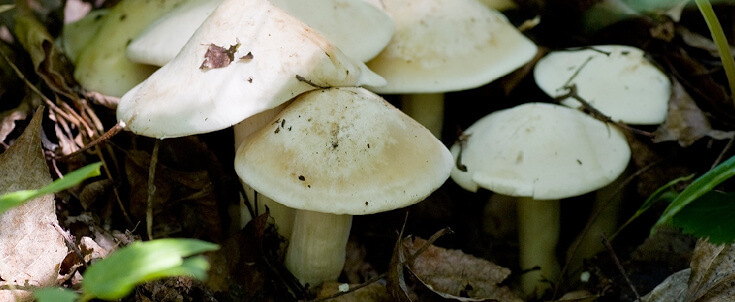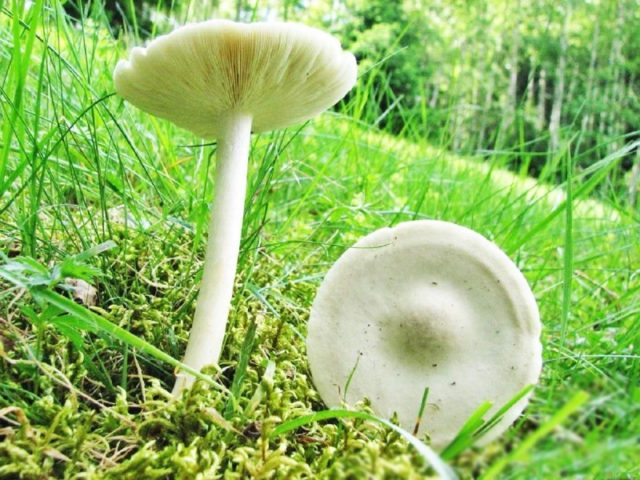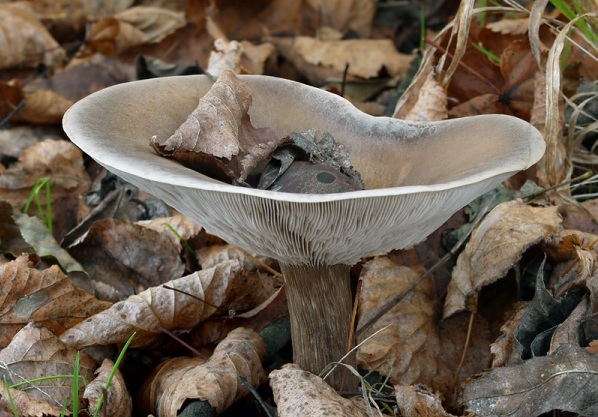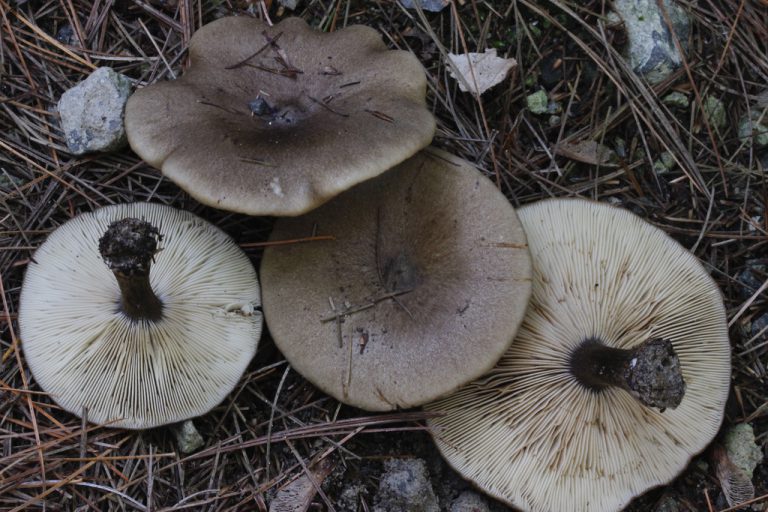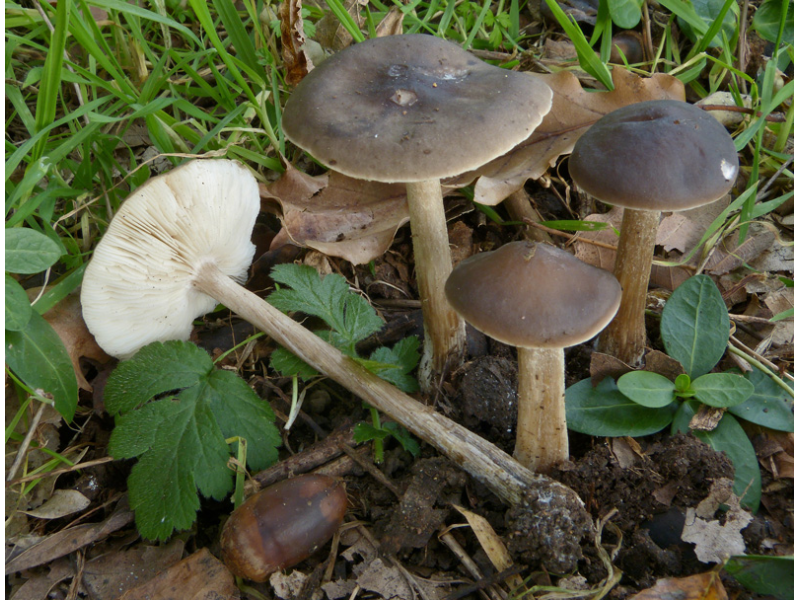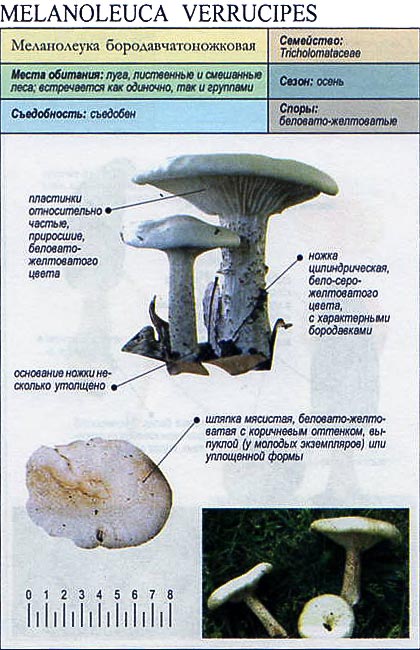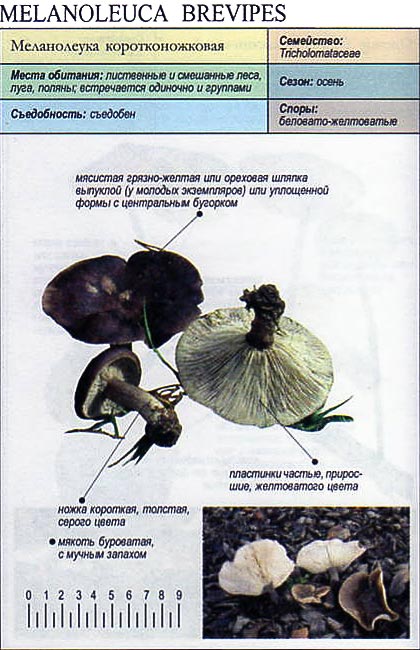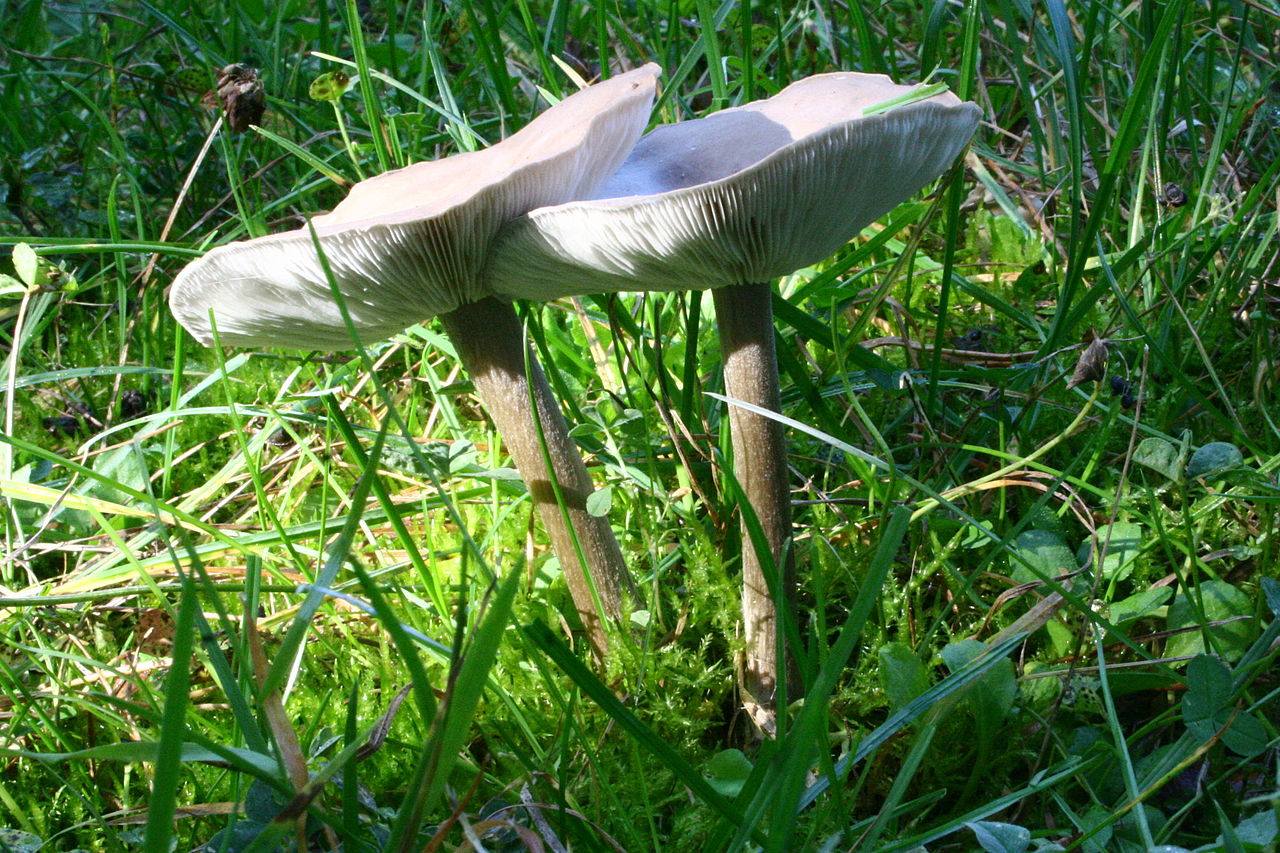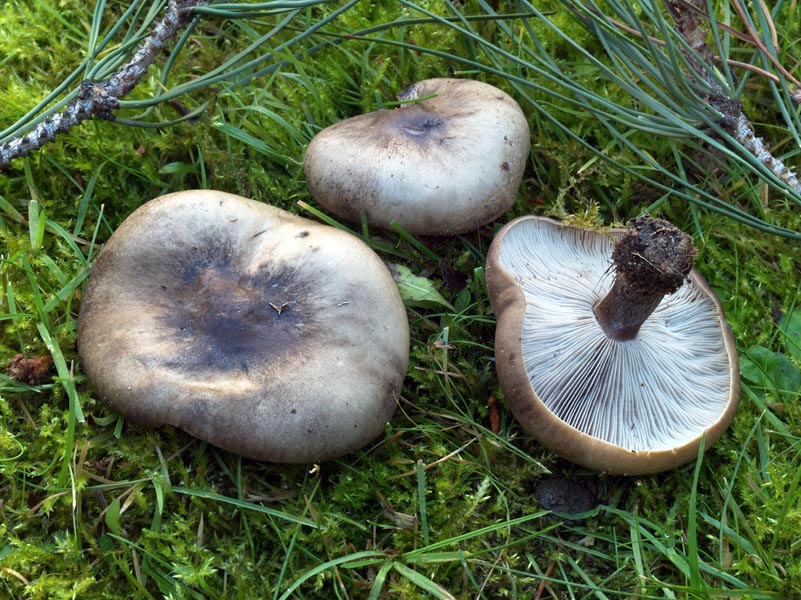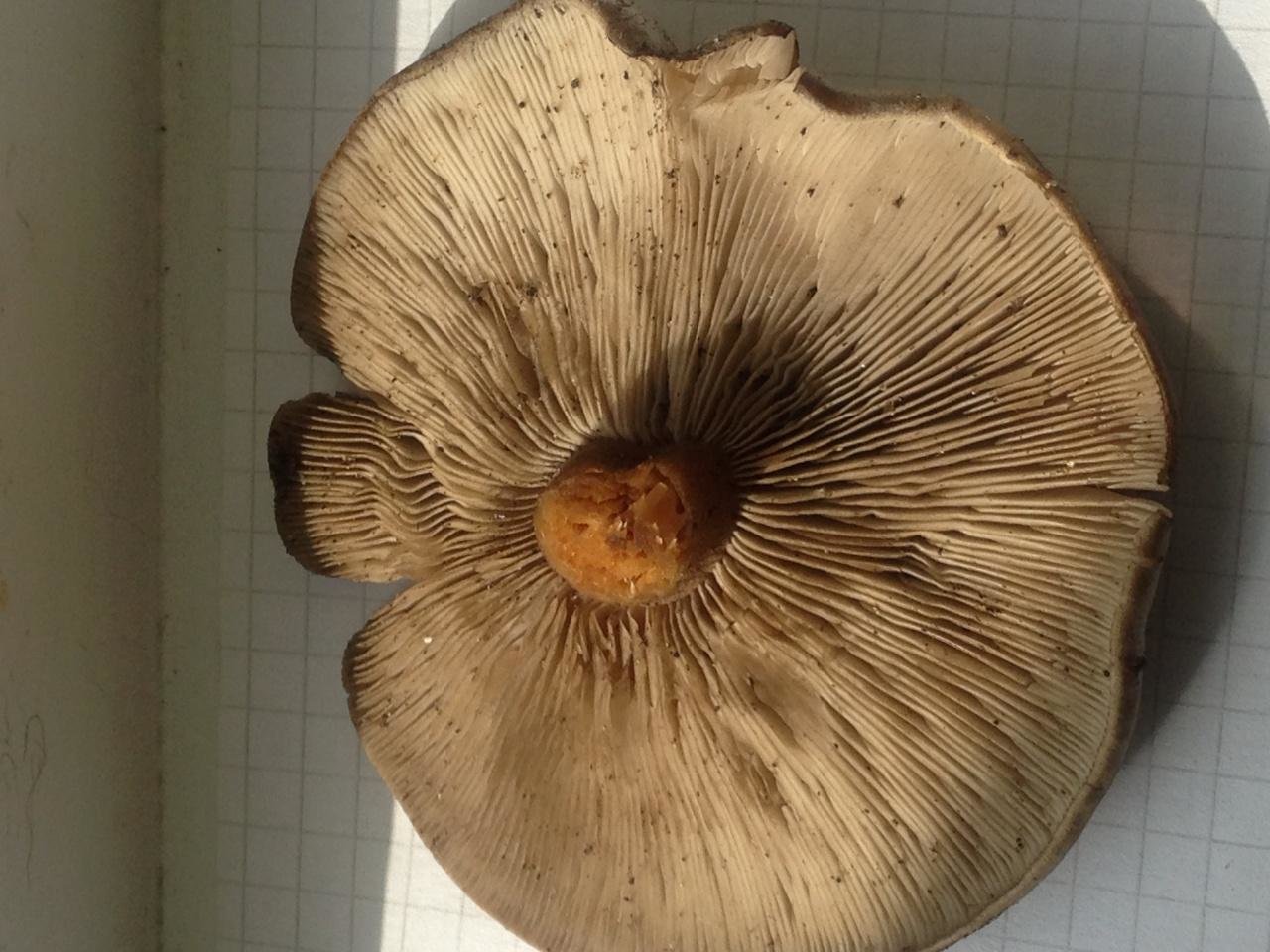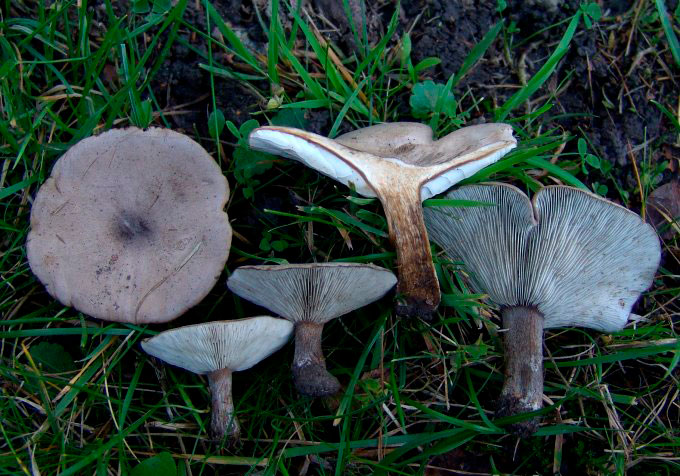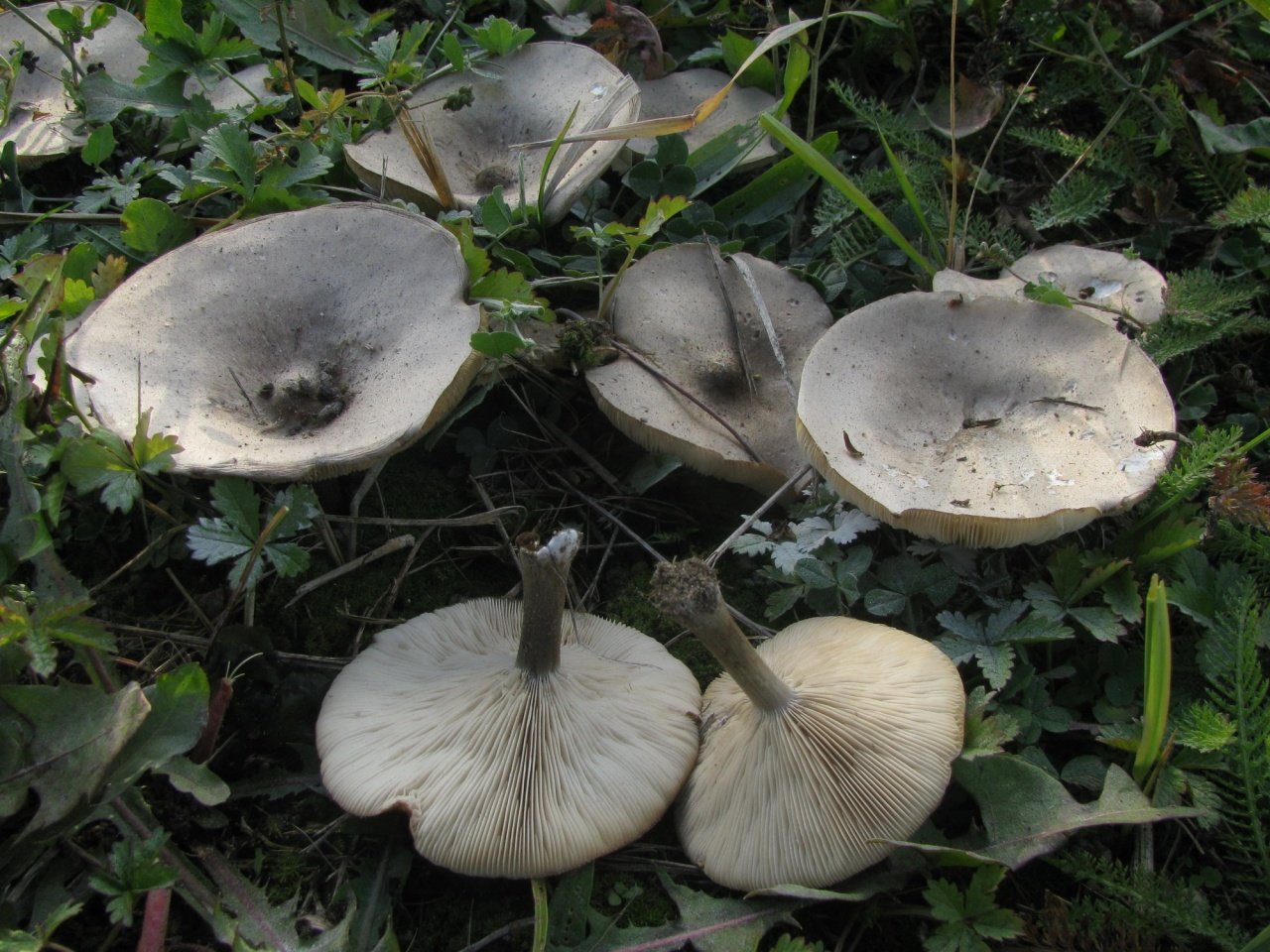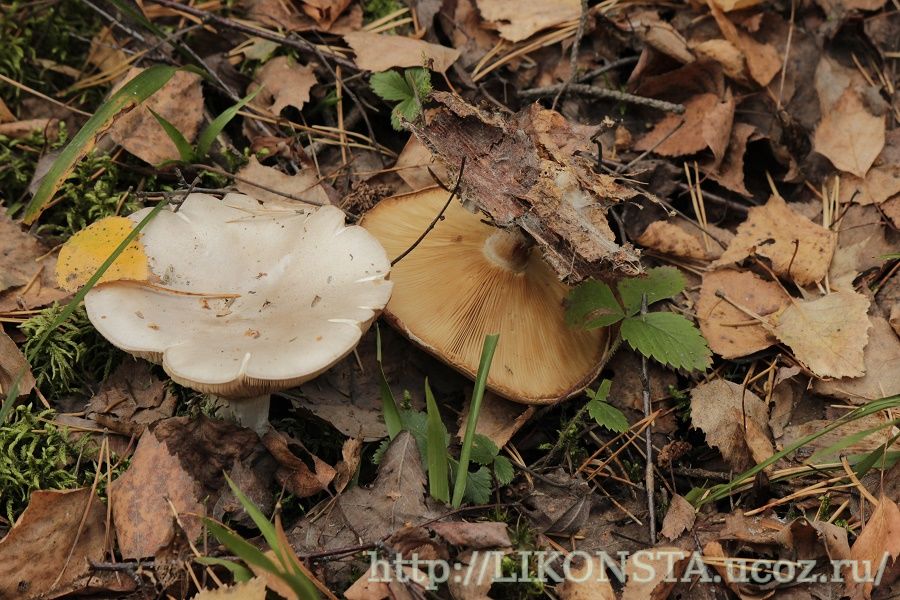Melanoleuca black and white
Melanoleuca black and white (lat.Melanoleuca melaleuca).
Other names:
- Melanoleuca cognata
- Melanoleuca vulgaris
- Melanolevka ordinary
Melanoleuca black and white is an edible lamellar mushroom that grows singly from late July to mid September. Most often, it can be found in open areas of mixed and deciduous forests, in gardens, parks, meadows and along roadsides.
Hat
The cap of the mushroom is convex, in the process of growth it gradually flattens, becoming prostrate, with a slight bulge in the middle. Its diameter is about 10 cm. The surface of the cap is smooth, matte, with a slightly pubescent edge, painted in a grayish brown color. In hot dry summers it fade to a pale brown color, retaining its original color only in the center.
Leg
Stem thin, rounded, 5-7 cm long and about 0.5-1 cm in diameter, slightly widened, with a root nodule or curved to the side, dense, fibrous, longitudinally ribbed, with longitudinal black hair fibers, brownish-brownish. Its surface is matte, dry, brownish in color, on which longitudinal black furrows are clearly visible.
Pulp
The flesh in the cap is soft, loose, elastic in the stem, fibrous, initially light gray, brown in mature mushrooms. Has a subtle spicy scent.
Places and times of collection
Melanoleuca black and white most often settles on rotting brushwood and fallen trees in forests.
In deciduous and mixed forests, parks, gardens, meadows, glades, forest edges, in light, usually grassy places, along the roadsides. Singles and in small groups, not often.
In the Moscow region, it is often found throughout the entire region from May to October.
Edibility
It is considered an edible mushroom, used fresh (boiled for about 15 minutes).
No poisonous species are found among representatives of the genus Melanoleuca
It is better to collect only caps that can be boiled or fried, the legs are fibrous-rubbery, inedible.
The mushroom is edible, little known. It is consumed fresh and salted.
Melanoleuca short-legged (Melanoleuca brevipes)
Synonyms:
- Agaricus brevipes
- Gymnopus brevipes
- Tricholoma brevipes
- Gyrophila brevipes
- Gyrophila grammopodia var. brevipes
- Tricholoma melaleucum subvar. brevipes
In a genus filled with hard-to-identify fungi, this melanoleuca stands (Or, better to say, “crouches”? In general, stands out) from the crowd with its gray hat and seemingly truncated leg, which seems disproportionately short for such a wide hat, much shorter than most members of the Melanoleuca genus. Of course, there are differences at the microscopic level as well.
Description
Hat: 4-10 cm in diameter, according to various sources - up to 14. Convex in young mushrooms, rather quickly becomes prostrate, sometimes with a shallow central bulge. Smooth, dry. Dark gray to nearly black in young specimens, turns gray over time, pale gray, and eventually fades to a dull brownish gray or even light brownish.
Plates: adherent, usually serrated, or almost free. White, frequent.
Leg: 1-3 cm long and 1 cm thick or slightly more, solid, dense, longitudinally fibrous. Sometimes twisted, in young mushrooms it is often in the form of a club, it evens out with growth, a slight thickening may remain at the base. Dry, cap color or slightly darker.
Flesh: Whitish at the cap, brownish to brown at the stem.
Smell and taste: Faint, almost indistinguishable. Some sources describe the taste as "pleasant starchy".
Spore powder: White.
Microscopic features: spores 6.5-9.5 * 5-6.5 microns. More or less elliptical, decorated with amyloid projections ("warts").
Ecology: probably saprophyte.
Habitat and fruiting period
Fruiting in summer and autumn, some sources indicate - from spring, and even from early spring. It is found in grassy areas, on pastures, forest edges and on soils with a disturbed structure, often in urban areas, parks, squares. It was noted that the mushroom is widespread in Europe and North America, probably not rare in other regions of the planet.
Edibility
A little-known edible mushroom of average taste. Some sources attribute it to the fourth category of edible mushrooms. It is recommended to boil it before use.
Similar species
It is believed that thanks to such a disproportionately short stem, Melanoleuca short-legged simply cannot be confused with any other mushrooms. At least not with any spring mushrooms.
Photo: Alexander.
Melanoma, what is it?
Melanocytes synthesize pigments that are responsible for coloring the skin, eye color, hair. Pigmented growths overflowing with melanin are called moles and can persist throughout life. Certain causal factors of exogenous (from the Greek. "Exo" - external) and endogenous ("endo" - internal) character can cause malignancy of nevi. As a result, areas of the body where there are congenital or acquired nevi are at risk of developing melanoma: the skin, less often the mucous membranes and the retina of the eye. The altered cells are able to multiply and grow uncontrollably, forming a tumor, metastasizing. Most often, among the benign "fellows", a single malignant neoplasm is found.
The clinical picture is varied. The size, shape, surface, pigmentation, and density of the tumor vary widely. Any changes that occur with a mole should be alerted.
Consumption
After collecting the melanoleucus, the straight-legged should not be stored for more than 3 hours. Upon arrival home, they immediately begin to process it. After cleaning, the fruits are poured with cold, slightly salted water, allowed to settle for half an hour. This manipulation will make it possible to clean up the straight-legged melanoleucus much better and bring the worms out if a specimen eaten by them falls into the basket.
Straight-footed melanoleucus is prepared by subjecting it to heat treatment. Peeled and washed mushrooms are boiled in drinking water for 15-20 minutes, the first broth is drained. After the fruiting body is boiled again, fried or stewed.
You can prepare straight-legged melanoleucus for the winter. It is pickled and rolled up in a jar of vinegar. You can also simply dry it, then add it to soups or roasts.
Straight-legged meloanoleuca is suitable for cooking any mushroom dishes: casseroles, sauces, goulash, filling for pies, cutlets, zraz and dumplings. It goes well with sour cream sauce. In a dried, crushed form, the fruit body of the straight-legged is used as a mushroom seasoning.
Nutrition for melanoma
General description of the disease
Melanoma is the most dangerous type of skin cancer that develops from pigment cells (melanocytes). Sometimes the disease affects not only the skin, but the retina, mucous membranes (vagina, oral cavity, rectum).
Prerequisites for the development of melanoma
Excessive exposure to ultraviolet light of sensitive skin or radiation, the presence of a large number of freckles or moles, age over 50 years, nevus injury, hormonal changes in the body, Dubreus melanosis, genetic predisposition, xeroderma pigmentosa, male sex.
Signs of melanoma are changes in the mole (nevus):
increased growth of a mole, a change in its surface, uneven compaction, weakening or increased color, the appearance of an erythematous border, hair loss in the area of the nevus, pinpoint pigmentation on the skin around the mole, bleeding of the nevus, burning, itching, soreness.
Varieties of melanoma:
- malignant lentig;
- superficially spreading melanoma;
- acral-lentiginous form of melanoma;
- nodular melanoma;
- melanoma with a phase of radial growth that is not classified.
Depending on the causes of the occurrence:
- melanoma that arises from precancerous melanosis or Hutchinson's melanotic spot;
- melanoma, which arises from a blue nevus;
- melanoma that arises from a large pigmented nevus.
Healthy foods for melanoma
Diet for melanoma should be complete, with the right amount of protein, calories and a minimum amount of saturated fat. Try to cook food without fat (steam, in a special pot or in the oven), do not follow extreme diets and do not consume large doses of individual supplements, foods or vitamins. The diet should include:
- green tea;
- spices (camun, turmeric, cumin, saffron and rosemary);
- fish rich in omega-3 acid (salmon, sardine, mackerel, tuna);
- foods with unsaturated, monounsaturated or polyunsaturated fats (sunflower, soy, corn oil, fish oil, olives and peanuts);
- boiled or raw vegetables;
- fruits and fresh fruit juices (apples, cherries, blueberries);
- low-fat and natural dairy products (milk, yogurt, kefir and cheese);
- complex hydrocarbons (bran bread, durum pasta, brown rice, porridge);
- simple, purified water in large quantities;
- Selenium-containing foods (baked chicken breast, turkey, low-fat homemade cheese, selenium-fortified bread, cheddar cheese, Brazil nuts, pork and lamb kidneys, lobster, squid, mussels, oysters, shrimps);
- cruciferous vegetables (Brussels sprouts and cabbage, cauliflower, kohlrabi, broccoli, Chinese cabbage, radish, turnip, horseradish and rutabaga);
- wasabi sauce;
- kelp (seaweed);
- lycopene (natural ketchup, tomato sauce, fresh tomatoes, tomato juice);
- leafy greens (parsley, dill, celery, spinach, green onions, rhubarb, watercress, parsnips, sorrel, wheat germ, edible seaweed);
- dietary fiber (components of plant cells, fiber).
Folk remedies for melanoma
- stone oil (five grams of stone oil per 0.5 liters of water, insist for three days, drain the resulting residue) to use for frequent lotions;
- kirkazon root (half a glass of crushed root, one teaspoon of sour cream, pour a glass of honey with 3 liters of water, insist warm for a week), take half a glass before meals for two months;
- Lycopodium pollen is used to dust the affected skin;
- decoction of lycopodium (boil one spoonful of pollen for fifteen minutes in a glass), take one glass a day;
- use juniper berries for compresses in gauze;
- use yeast (thick solution) for compresses, covering with a thin towel on top;
- marshmallow primark (in equal proportions, pour the flowers or root with water, boil for fifteen minutes, insist for two hours);
- freshly squeezed sea buckthorn juice.
Dangerous and harmful foods for melanoma
Exclude the following foods: fatty foods and foods high in trans fats (lard and fatty meats, butter and ghee, mayonnaise, pizza, burgers, sandwiches, fast food, fatty pork and beef, milk chocolate, sweets, fried foods, pastries, ice cream, coffee and milkshakes).
Limit the use of such products as: foods containing omega-6 (eel fat, vegetable oils (rapeseed, linseed, cottonseed, sunflower, soybean, hemp, safflower), pumpkin and sunflower seeds, nuts (pine nuts, pistachios), eggs, offal, animal fats and butter).
Melanoleuca striped (Melanoleuca grammopodia)
Synonyms for the main name of the species are Latin terms:
- Melanoleuca grammopodium,
- Gyrophila grammopodia,
- Tricholoma grammopodium,
- Entoloma placenta.
Malanoleuca striped (Melanoleuca grammopodia) is a mushroom of the Tricholomataceae family.
External description of the mushroom
The fruiting body of striped melanoleuca consists of a cylindrical and slightly thickened leg at the bottom, and an initially convex and subsequently outstretched cap.
The length of the mushroom leg does not exceed 10 cm, and its diameter varies within 0.5-2 cm. Longitudinal fibers of a dark brown color are visible on the surface of the leg. If you cut off the leg at the base, then that place is sometimes brown or dark gray in color.The leg is characterized by great rigidity.
The diameter of the mushroom cap can be up to 15 cm. In mature mushrooms, the cap is characterized by a lowered edge, high density, a depressed surface and a characteristic tubercle in the center. The top layer is smooth and matte skin, which can be slightly shiny. The color of the cap of the striped-legged malanoleuca is different: off-white, ocher, nutty. As the mushroom matures, the color of the cap becomes faded.
The lamellar hymenophore, located on the inner side of the cap, is represented by often located, convoluted plates, which can sometimes be forked, serrated and grow to the stem of the fungus. Initially, the plates are white, but later become creamy.
The pulp of the described type of mushroom is elastic, has a whitish-gray color, and in ripe fruit bodies it becomes brown. The smell of the pulp is inexpressive, but often unpleasant, musty and mealy. Her taste is sweetish.
Habitat and fruiting period
Melanoleuca striped (Melanoleuca grammopodia) grows in deciduous and mixed forests, in parks, gardens, pine forests, meadows, meadow areas, forest edges, well-lit grassy places. Sometimes it grows on the side of roads, in groups or singly. When warm weather is established in the spring, striped-legged malanoleucks can appear even in the month of April, but usually the period of mass fruiting of this type of mushroom begins in May. From July to September, small groups of striped-legged malanoleuca or solitary mushrooms are found in spruce forests.
Edibility
The mushroom is edible, it can be consumed in any form, even fresh, without prior boiling. Melanoleuca striped is good when boiled.
What does skin melanoma look like: photo
Early melanoma may go unnoticed
It attracts attention after changing the color to a darker color of the mole or due to the growth of a tumor. The causes of skin melanoma are various:
- Ultraviolet irradiation. Melanoma often develops in people who like artificial and natural tanning, after sunburn.
- Nevi (moles), melaniform nevus.
- A genetic predisposition to the development of melanoma, for which a specific gene is responsible.
- I and II skin phenotype. The rest of the skin phenotypes are less prone to the formation of a malignant skin tumor. The most susceptible to the development of cancer are people with fair skin, light hair color, blue, gray eyes, freckles.
- Hereditary hypersensitivity to ultraviolet rays.
- Skin injuries, moles.
- Diseases of the organs of the endocrine system.
- Age-related changes.
- A history of skin cancer treatment is a predisposing factor.
Expert opinion
Head of the Oncology Department, Oncologist, Chemotherapist
Melanoma is one of the malignant neoplasms characterized by an aggressive course. Mortality from skin cancer accounts for 40% of all cases of oncology. Diagnosis of melanoma in the Russian Federation is carried out quite often. 9000–10000 disease debuts are detected annually. The tendency towards an increase in severe forms due to untimely treatment, when doctors can only offer palliative therapy, is not encouraging.
Oncologists at the Yusupov Hospital pay careful attention to the diagnosis and treatment of melanoma. Doctors advise seeking medical attention if suspicious lesions appear on the skin.
In a similar way, you can identify the disease at the initial stages and carry out appropriate treatment. In addition, in the early stages, melanoma is characterized by a favorable prognosis for recovery.
At the Yusupov hospital, doctors conduct a full course of examination, which is necessary to determine the stage of development of skin cancer and all related criteria. As a result of determining an accurate diagnosis, the effectiveness of the prescribed complex therapy increases.The drugs are selected according to the latest European guidelines for the treatment of skin tumors.
Melanoma of the skin: life projections
Melanoma skin cancer. Photo
Melanoma develops from specialized melanocyte cells that produce the pigment melanin. Melanocytes are responsible for the color of the eyes, hair, skin, and are responsible for protecting the body from ultraviolet rays. Most often, a malignant neoplasm is localized on the skin, less often in the area of the mucous membranes of the rectum, vagina, oral cavity, and also a tumor can form on the retina of the eye. Melanoma is rare, but mortality from melanoma is high - the tumor is prone to metastasis and the formation of secondary foci.
In the oncology department of the Yusupov hospital, patients will be able to receive qualified advice from a dermatologist, oncologist, undergo skin melanoma diagnostics, and undergo treatment for the disease. The oncology department is equipped with modern equipment; the hospital treats malignant diseases using innovative methods with the use of modern medicines.
Melanoleuca black and white
Melanoleuca black and white (lat.Melanoleuca melaleuca).
Other names:
- Melanoleuca cognata
- Melanoleuca vulgaris
- Melanolevka ordinary
Melanoleuca black and white is an edible lamellar mushroom that grows singly from late July to mid September. Most often, it can be found in open areas of mixed and deciduous forests, in gardens, parks, meadows and along roadsides.
Hat
The cap of the mushroom is convex, in the process of growth it gradually flattens, becoming prostrate, with a slight bulge in the middle. Its diameter is about 10 cm. The surface of the cap is smooth, matte, with a slightly pubescent edge, painted in a grayish brown color. In hot dry summers it fade to a pale brown color, retaining its original color only in the center.
Leg
Stem thin, rounded, 5-7 cm long and about 0.5-1 cm in diameter, slightly widened, with a root nodule or curved to the side, dense, fibrous, longitudinally ribbed, with longitudinal black hair fibers, brownish-brownish. Its surface is matte, dry, brownish in color, on which longitudinal black furrows are clearly visible.
Pulp
The flesh in the cap is soft, loose, elastic in the stem, fibrous, initially light gray, brown in mature mushrooms. Has a subtle spicy scent.
Places and times of collection
Melanoleuca black and white most often settles on rotting brushwood and fallen trees in forests.
In deciduous and mixed forests, parks, gardens, meadows, glades, forest edges, in light, usually grassy places, along the roadsides. Singles and in small groups, not often.
In the Moscow region, it is often found throughout the entire region from May to October.
Edibility
It is considered an edible mushroom, used fresh (boiled for about 15 minutes).
No poisonous species are found among representatives of the genus Melanoleuca
It is better to collect only caps that can be boiled or fried, the legs are fibrous-rubbery, inedible.
The mushroom is edible, little known. It is consumed fresh and salted.
Definitioner
- Basidia (Basidia)
-
Lat. Basidia. A specialized structure of sexual reproduction in fungi, inherent only in Basidiomycetes. Basidia are terminal (end) elements of hyphae of various shapes and sizes, on which spores develop exogenously (outside).
Basidia are diverse in structure and method of attachment to hyphae.
According to the position relative to the axis of the hypha, to which they are attached, three types of basidia are distinguished:
Apical basidia are formed from the terminal cell of the hypha and are located parallel to its axis.
Pleurobasidia are formed from lateral processes and are located perpendicular to the axis of the hypha, which continues to grow and can form new processes with basidia.
Subasidia are formed from a lateral process, turned perpendicular to the axis of the hypha, which, after the formation of one basidium, stops its growth.
Based on morphology:
Holobasidia - unicellular basidia, not divided by septa (see Fig. A, D.).
Phragmobasidia are divided by transverse or vertical septa, usually into four cells (see Fig. B, C).
By type of development:
Heterobasidia consists of two parts - hypobasidia and epibasidia developing from it, with or without partitions (see Fig. C, B) (see Fig. D).
Homobasidia is not divided into hypo- and epibasidia and in all cases is considered holobasidia (Fig. A).
Basidia is the place of karyogamy, meiosis and the formation of basidiospores. Homobasidia, as a rule, is not functionally divided, and meiosis follows karyogamy in it. However, basidia can be divided into probasidia - the site of karyogamy and metabasidia - the site of meiosis. Probasidium is often a dormant spore, for example in rust fungi. In such cases, probazidia grows with metabasidia, in which meiosis occurs and on which basidiospores are formed (see Fig. E).
See Karyogamy, Meiosis, Gifa.
- Pileipellis
-
Lat. Pileipellis, skin - differentiated surface layer of the cap of agaricoid basidiomycetes. The structure of the skin in most cases differs from the inner flesh of the cap and may have a different structure. The structural features of pileipellis are often used as diagnostic features in descriptions of fungi species.
According to their structure, they are divided into four main types: cutis, trichoderma, hymeniderma and epithelium.
See Agaricoid fungi, Basidiomycete, Cutis, Trichoderma, Gimeniderm, Epithelium.
Collection rules
Fruit bodies ripen from early summer to September. The short stem of the mushroom "sits" loosely in the ground, so it will not be difficult to remove it from there.
When collecting melanoleuca, important rules must be followed:
- it is best to go to the forest for mushrooms in the early morning, until the dry dew begins;
- warm nights after heavy rains - perfect weather for a wonderful mushroom harvest;
- it is not necessary to collect rotten, overripe, withered, mechanically or insect damaged specimens, since they have already begun to release toxins;
- an excellent container for collecting mushrooms - wicker baskets that provide easy access to air, polyethylene bags are definitely not suitable;
- The short-legged melanoleucus is best cut with a knife, but it is quite possible and careful to pull it out, slightly twisting and swinging it from side to side.
Although it is a non-poisonous mushroom, it should not be tasted raw.
Melanoleuca black and white
Melanoleuca black and white (lat.Melanoleuca melaleuca).
Other names:
- Melanoleuca cognata
- Melanoleuca vulgaris
- Melanolevka ordinary
Melanoleuca black and white is an edible lamellar mushroom that grows singly from late July to mid September. Most often, it can be found in open areas of mixed and deciduous forests, in gardens, parks, meadows and along roadsides.
Hat
The cap of the mushroom is convex, in the process of growth it gradually flattens, becoming prostrate, with a slight bulge in the middle. Its diameter is about 10 cm. The surface of the cap is smooth, matte, with a slightly pubescent edge, painted in a grayish brown color. In hot dry summers it fade to a pale brown color, retaining its original color only in the center.
Leg
Stem thin, rounded, 5-7 cm long and about 0.5-1 cm in diameter, slightly widened, with a root nodule or curved to the side, dense, fibrous, longitudinally ribbed, with longitudinal black hair fibers, brownish-brownish. Its surface is matte, dry, brownish in color, on which longitudinal black furrows are clearly visible.
Pulp
The flesh in the cap is soft, loose, elastic in the stem, fibrous, initially light gray, brown in mature mushrooms. Has a subtle spicy scent.
Places and times of collection
Melanoleuca black and white most often settles on rotting brushwood and fallen trees in forests.
In deciduous and mixed forests, parks, gardens, meadows, glades, forest edges, in light, usually grassy places, along the roadsides.Singles and in small groups, not often.
In the Moscow region, it is often found throughout the entire region from May to October.
Edibility
It is considered an edible mushroom, used fresh (boiled for about 15 minutes).
No poisonous species are found among representatives of the genus Melanoleuca
It is better to collect only caps that can be boiled or fried, the legs are fibrous-rubbery, inedible.
The mushroom is edible, little known. It is consumed fresh and salted.
What does skin melanoma look like? Photo - 54 pcs.
What does melanoma look like? The appearance on the surface of the skin of a small spot, a gray-yellow nodule, or a shiny plaque. In the early stages, the disease has no subjective manifestations and does not cause any discomfort. With an increase in the tumor, it can begin to itch, itch, there is a feeling of discomfort, tingling. Further in the middle of the neoplasm, a small weeping ulcer may appear. Sometimes it starts to bleed or crust over. The middle of this formation can heal, but at the same time the tendency to peripheral growth remains. On palpation of the base of this neoplasm, some tissue compaction can be felt, although there are no signs of inflammation.
Just a terrible and terrible disease. It should be treated immediately as soon as melanoma is suspected. It is good that we have experienced doctors who can help and cure this horror.
Please give me the coordinates of good doctors.
Tell a specialist in the treatment of melanoma in St. Petersburg.
Melanoleuca short-legged
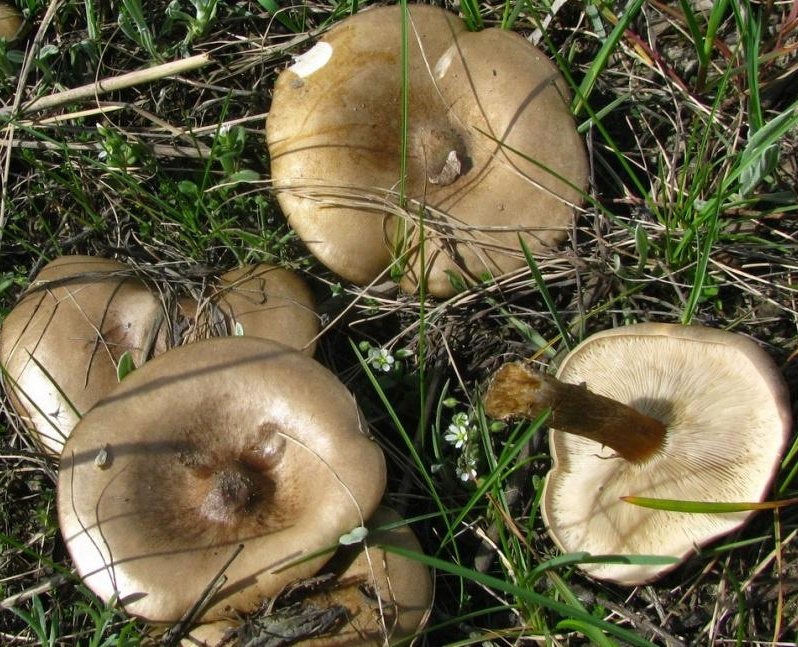
Melanoleica short-legged
In a genus filled with hard-to-identify fungi, this melanoleuca stands (Or, better to say, “crouches”? In general, stands out) from the crowd with its gray hat and seemingly truncated leg, which seems disproportionately short for such a wide hat, much shorter than most members of the Melanoleuca genus. Of course, there are differences at the microscopic level as well.
Description
Hat: 4-10 cm in diameter, according to various sources - up to 14. Convex in young mushrooms, rather quickly becomes prostrate, sometimes with a shallow central bulge. Smooth, dry. Dark gray to nearly black in young specimens, turns gray over time, pale gray, and eventually fades to a dull brownish gray or even light brownish.
Plates: adherent, usually serrated, or almost free. White, frequent.
Leg: 1-3 cm long and 1 cm thick or slightly more, solid, dense, longitudinally fibrous. Sometimes twisted, in young mushrooms it is often in the form of a club, it evens out with growth, a slight thickening may remain at the base. Dry, cap color or slightly darker.

Flesh: Whitish at the cap, brownish to brown at the stem.
Smell and taste: Faint, almost indistinguishable. Some sources describe the taste as "pleasant starchy".
Spore powder: White. Microscopic features: spores 6.5-9.5 * 5-6.5 microns. More or less elliptical, decorated with amyloid projections ("warts").
Ecology: probably saprophyte.
Habitat and fruiting period
Fruiting in summer and autumn, some sources indicate - from spring, and even from early spring. It is found in grassy areas, on pastures, forest edges and on soils with a disturbed structure, often in urban areas, parks, squares. It was noted that the mushroom is widespread in Europe and North America, probably not rare in other regions of the planet.
Edibility
A little-known edible mushroom of average taste. Some sources attribute it to the fourth category of edible mushrooms. It is recommended to boil it before use.
Similar species
It is believed that thanks to such a disproportionately short stem, Melanoleuca short-legged simply cannot be confused with any other mushrooms. At least not with any spring mushrooms.
Mushroom photo Melanoleuca short-legged from questions in recognition:
Melanoleuca short-legged: description and photo
| Name: | Melanoleuca short-legged |
| Latin name: | Melanoleuca brevipes |
| Type of: | Edible |
| Synonyms: | Short-legged melanolecus, Short-legged melanoleke, Agaricus brevipes, Gymnopus brevipes, Tricholoma brevipes, Gyrophila brevipes, Gyrophila grammopodia var brevipes, Tricholoma melaleucum subvar brevipes |
| Specifications: | |
| Systematics: |
|
Melanoleuca (melanoleuca, melanoleuca) is a poorly studied species of edible mushrooms, represented by more than 50 varieties. Its name comes from the ancient Greek "melano" - "black" and "leukos" - "white". Traditionally, the species is considered to be in the Ryadovkovy family, but recent DNA studies have revealed their relationship with the Pluteyevs and Amanitovs. Short-legged melanoleuca is an easily recognizable mushroom. He has external features, thanks to which he cannot be confused with any other.
How short-legged melanoleucks look
A small, medium-sized lamellar mushroom, vaguely resembling a russula. The fruiting body has a distinctive cap and stem imbalance. The cap is 4-12 cm in diameter, convex in young specimens, later horizontally spread with a specific tubercle in the middle and a wavy edge. The skin is smooth, dry, matte. Its color can be very different: grayish-brown, nutty, dirty yellow, often with an olive tint; in hot dry summers it fades, becomes light gray or pale yellow. The hymenophore is represented by frequent, adherent, sandy-brown plates descending along the leg. The cephalic ring is missing. The leg is short (3-6 cm), rounded, tuberous at the very base, longitudinally fibrous, of one color with a cap. The pulp is soft, tender, brownish, darker and harder in the stem.

